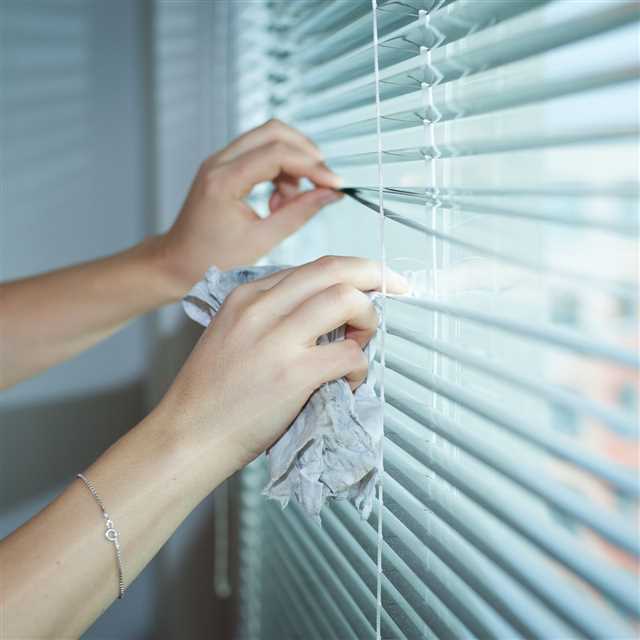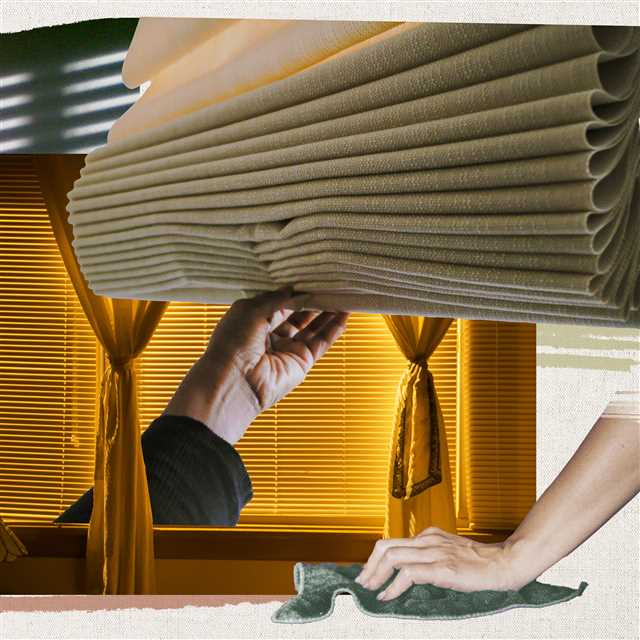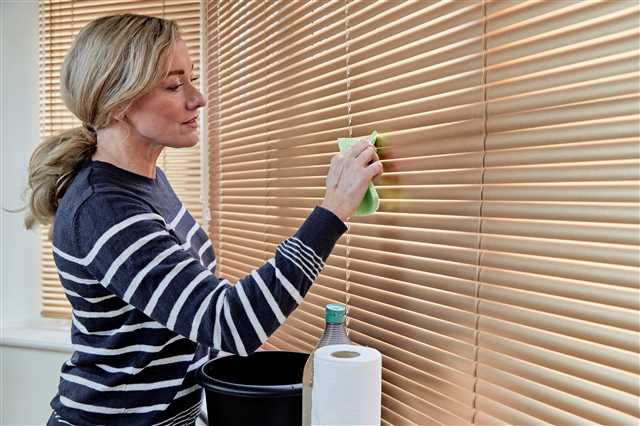
When it comes to cleaning fabric blinds, it’s important to know the right methods to ensure the best results. Fabric blinds are a popular choice for many homeowners due to their aesthetic appeal and versatility. However, without proper maintenance, they can still accumulate dust, dirt, and stains over time.
One effective method for cleaning fabric blinds is by using a soft brush to gently remove dust and dirt. Begin by closing the blinds and brushing the flat parts in a downward motion. Then, open the blinds and repeat the process on the other side. For pleated blinds, it’s recommended to use a brush with softer bristles to prevent any damage to the delicate fabric.
If there are any stubborn stains on the fabric blinds, a mild cleaning solution can be used. Before applying any solution, it’s always important to test it on a small, inconspicuous area of the blinds to ensure it doesn’t cause any discoloration or damage. Once a suitable solution has been chosen, apply it to a soft cloth and gently blot the stain. Avoid rubbing the fabric vigorously, as this can lead to further damage.
For fabric blinds that are washable, they can be soaked in a bathtub filled with warm water and mild detergent. Make sure to read the manufacturer’s instructions beforehand to ensure the fabric can withstand submersion. After soaking, rinse the blinds well and lay them flat to dry. It’s important to avoid using bleach or hot water, as this can damage the fabric.
If the blinds are not washable, a spot cleaning method can be used. Begin by dampening a soft cloth with a mild cleaning solution. Gently dab the stained area, being careful not to saturate the fabric. Rinse the cloth and continue dabbing until the stain is lifted. Allow the blinds to air dry before rehanging them.
In conclusion, cleaning fabric blinds doesn’t have to be a daunting task. With the right methods and materials, you can easily maintain the cleanliness and appearance of your blinds. Whether you choose to brush, wash, or spot clean them, remember to always test any cleaning solution or method on a small, inconspicuous area first to avoid any potential damage. By following these simple and effective methods, you can keep your fabric blinds looking great for years to come.
- How to Clean Fabric Blinds: Simple and Effective Methods
- Gather Your Supplies
- Start Cleaning from the Top
- Using a Sponge or Brush
- Choosing the Right Cleaner
- Using Lemon for Stain Removal
- Cleaning Vertical Fabric Blinds
- Washing Fabric Blinds in a Bathtub
- Drying and Rehanging the Blinds
- Final Tips
- Preparing the Blinds
- 1. Close the Blinds
- 2. Dusting
- 3. Vacuuming
- 4. Spot Cleaning
- 5. Open the Blinds
- Vacuuming the Blinds
- Supplies Needed
- Steps to Vacuum Fabric Blinds
- Spot Cleaning Stains
- What You’ll Need
- Step-by-Step Instructions
- Washing the Blinds
- Step 1: Prepare the Area
- Step 2: Wipe Down the Blinds
- Step 3: Remove Stains and Spots
- Step 4: Machine Wash or Hand Wash
- Step 5: Rinse and Dry
- Step 6: Iron or Steam
- Drying and Rehanging the Blinds
- Video:
- How to Clean Cellular Shades | Blinds.com
How to Clean Fabric Blinds: Simple and Effective Methods
Fabric blinds are a popular window covering option that adds a touch of elegance and functionality to any room. However, like any other household item, they need regular cleaning to maintain their beauty and functionality. In this guide, we will discuss simple and effective methods to clean fabric blinds, ensuring they stay in great condition for years to come.
Gather Your Supplies
Before you start cleaning your fabric blinds, gather the following supplies:
- A sponge or a soft brush
- A mild detergent or fabric cleaner
- Lukewarm water
- A lemon (optional)
- A bathtub (for larger blinds)
- A towel or a drying rack
Start Cleaning from the Top
When cleaning your fabric blinds, it’s best to start from the top and work your way down. This helps prevent dirty water from running down over already cleaned areas.
Using a Sponge or Brush
If your fabric blinds only have light dust or dirt, a simple sponge or soft brush can do the job. Gently scrub the blinds in a back-and-forth motion, paying attention to both sides of the material.
Choosing the Right Cleaner
If your blinds are heavily soiled or have stubborn stains, a mild detergent or fabric cleaner can be used. Follow the instructions on the cleaner’s label and dilute it with lukewarm water. Don’t use bleach or harsh cleaners, as they may damage the fabric or cause color fading.
Using Lemon for Stain Removal
If you have light-colored fabric blinds and need to remove stains, lemon can be a great natural alternative. Cut a lemon in half and rub it gently on the stains. The lemon’s acidity will help break down the stains and brighten up the fabric.
Cleaning Vertical Fabric Blinds
Vertical fabric blinds have a slightly different design but can be cleaned using similar steps. Pay special attention to each individual vertical strip and clean them thoroughly.
Washing Fabric Blinds in a Bathtub
If your fabric blinds are too large to clean by hand, you can wash them in a bathtub. Fill the bathtub with lukewarm water and a mild detergent, then place the blinds inside and let them soak for a few minutes. Gently brush any noticeable stains or spots, then rinse the blinds thoroughly.
Drying and Rehanging the Blinds
After cleaning, make sure to dry the blinds properly before rehanging them. You can either lay them flat on a towel or use a drying rack. Avoid hanging wet blinds, as this can lead to color bleeding or potential damage to the blinds or the windows themselves.
Final Tips
- Be careful when cleaning fabric blinds with valances, as they can be delicate. Spot clean them instead of brushing vigorously.
- If you’re unsure about the cleaning method for your specific fabric blinds, call the manufacturer for guidance.
- Regularly dust or vacuum your fabric blinds to prevent dirt buildup and prolong their lifespan.
By following these simple and effective methods, you can keep your fabric blinds looking clean, fresh, and beautiful. Remember to be gentle when cleaning and to choose the appropriate cleaning supplies for your blinds’ material. With proper care, your fabric blinds will continue to enhance the aesthetics and functionality of your home.
Preparing the Blinds
Before you start cleaning your fabric blinds, it’s important to properly prepare them. This step will ensure that you clean your blinds effectively and avoid any damage to the fabric material.
1. Close the Blinds
In order to clean the blinds properly, make sure they are fully closed. This will give you access to both sides of the blinds for dusting and cleaning.
2. Dusting
Get a fabric duster or a soft brush to remove any dust from the blinds. Start at the top and work your way down, being careful not to damage the fabric. Pay close attention to any recent posts or stains on the blinds.
3. Vacuuming
If your blinds are heavily soiled, vacuuming them is a good idea. Use a small brush attachment on your vacuum cleaner and gently go over each side of the blinds. This will help remove any dust or dirt that may be embedded in the fabric.
4. Spot Cleaning
If you notice any stains or spots on your blinds, you can spot clean them with a mild detergent. Mix a small amount of mild detergent with water and use a sponge or a soft cloth to gently clean the affected areas. Be careful not to oversaturate the fabric.
5. Open the Blinds
Once you have finished cleaning the blinds, open them to let them dry completely. This will also help prevent any mildew from forming on the fabric.
By taking the time to properly prepare your fabric blinds before cleaning them, you will ensure that they are cleaned effectively and that you avoid any damage to the material. This step-by-step guide will help you keep your fabric blinds in the best condition possible.
Vacuuming the Blinds
When it comes to cleaning fabric blinds, vacuuming is an essential first step. By gently removing dust and dirt from the blinds, you can ensure a thorough and effective cleaning process.
Supplies Needed
- Vacuum cleaner with a brush attachment
- Soft bristle brush or sponge
- White vinegar
- Mild soap solution
- Bath towel
Steps to Vacuum Fabric Blinds
- Start by closing the blinds to a flat position. This will make it easier to access all parts of the blinds.
- If you have Roman or cellular blinds, gently post them down to expose the fabric.
- Using the brush attachment on your vacuum cleaner, start by gently brushing the blinds from top to bottom. This will help loosen any dust or dirt that may be trapped in the fabric.
- Pay extra attention to areas with noticeable stains or spots. You may need to give those areas a little extra care.
- If there are any loose dust or dirt particles that didn’t come off during vacuuming, you can use a soft bristle brush or sponge to gently brush them away.
- If there are any stubborn stains that require further treatment, mix equal parts white vinegar and water to create a mild vinegar solution. Apply the solution to the stained area and let it sit for about 30 minutes before rinsing it off with a damp bath towel.
- If the fabric blinds are washable, carefully remove the headrail and follow the manufacturer’s instructions for proper washing.
- If your fabric blinds can’t be washed, you can spot clean them. Create a solution of mild soap and warm water, and use a sponge to gently wash the affected area. Blot the area with a towel to remove excess moisture.
- Dry the blinds thoroughly before reattaching the headrail or hanging them back in place. You can use a hairdryer on a low heat setting to speed up the drying process.
By regularly vacuuming your fabric blinds and following these cleaning tips, you can keep them looking fresh and clean for a long time. Remember to always check the manufacturer’s guide for specific cleaning instructions and avoid using bleach or harsh chemicals that can damage the fabric.
Spot Cleaning Stains
Even with regular cleaning, fabric blinds can occasionally develop stains or spots. When this happens, it’s important to spot clean the affected areas to maintain the overall cleanliness and appearance of the blinds.
What You’ll Need
- A sponge or cloth
- Mild dishwashing solution or fabric cleaner
- Warm water
Step-by-Step Instructions
- Identify the stained areas on your fabric blinds or shades. Be attentive and look for any spots that need special attention.
- Start by gently wiping the stained areas with a sponge or cloth soaked in a mixture of mild dishwashing solution or fabric cleaner and warm water. This solution will help to break down the stain without damaging the fabric.
- If you notice that the stain is stubborn and not coming off easily, try using a scrub brush or gently scrubbing with your fingers. Be careful not to scrub too hard, as this may cause damage to the fabric.
- For particularly tough stains, you can try using a paste made of salt and lemon juice. Apply the paste to the stain, let it sit for 30 minutes, and then wipe it off with a cloth or sponge.
- Once the stains are removed, wipe the area clean with a damp cloth or sponge to remove any remaining cleaning solution.
- Allow the fabric blinds or shades to air dry. If you have vertical fabric blinds, ensure they are in the open position to allow for quicker drying. For horizontal fabric blinds, you can gently lift them up to allow air circulation.
Remember, spot cleaning is intended for small areas and individual spots. If your fabric blinds or shades are heavily soiled or require a more thorough cleaning, it may be best to consult a professional cleaner or consider machine washing, if recommended by the manufacturer.
Washing the Blinds
Once you have completed the necessary tips for cleaning fabric blinds, then you can proceed to washing them. Follow the steps below to effectively wash your fabric blinds.
Step 1: Prepare the Area
Before you begin washing your fabric blinds, make sure to prepare the area. Remove any valances or curtains that may be attached to the blinds and set them aside.
Step 2: Wipe Down the Blinds
Using a duster or a dry cloth, wipe down the blinds to remove any loose dust or dirt. This step will help make the washing process easier and more effective.
Step 3: Remove Stains and Spots
If you notice any stains or spots on the fabric blinds, use a mild cleaner to scrub the affected areas. Be sure to test the cleaner on a small, inconspicuous area first to ensure compatibility with the fabric.
Step 4: Machine Wash or Hand Wash
Depending on the fabric type, you can either machine wash or hand wash your fabric blinds. Check the care label or manufacturer’s instructions to determine the appropriate method.
- Machine wash: If your fabric blinds are machine washable, place them in a mesh laundry bag and wash on a gentle cycle with cold or lukewarm water.
- Hand wash: If your fabric blinds are not machine washable, fill a bathtub or large basin with lukewarm water and a mild detergent. Gently agitate the blinds in the water, then let them soak for a sufficient amount of time.
Step 5: Rinse and Dry

After washing, rinse the blinds thoroughly with clean water to remove any remaining cleaner or soap residue. Squeeze out any excess water gently.
If your blinds are made of bamboo or other natural materials, hang them back up while still wet. The natural composition of these materials allows them to dry more effectively when hanging.
For fabric blinds, lay them flat on a clean, dry surface or use a drying rack. Avoid exposing them to direct sunlight or heat sources, as this may cause the fabric to warp or fade.
Step 6: Iron or Steam

If needed, iron or steam your fabric blinds to remove any wrinkles or creases that may have formed during the washing and drying process. Be sure to follow the manufacturer’s instructions for ironing or steaming.
By following these steps, you can ensure that your fabric blinds are thoroughly cleaned and maintained, allowing them to look beautiful and last longer.
Drying and Rehanging the Blinds

After cleaning your fabric blinds, it’s time to dry and rehang them. Here’s how:
- First, make sure that all excess water is removed from the blinds. You can gently squeeze the fabric to remove some of the water, but avoid wringing or twisting the blinds, as this can damage the fabric.
- If your blinds have valances or roller shades, take them down and dry them separately.
- Lay the blinds flat on a clean and dry surface, such as a table or countertop, making sure that they are spread out evenly.
- If possible, open any slats or vanes to allow air circulation and faster drying.
- If the blinds are made of a delicate fabric, you may want to place a towel or cloth underneath to absorb any excess water.
- Choose a well-ventilated area to dry the blinds. If you have access to an outdoor space, you can hang them outside to dry faster.
- If you’re drying the blinds indoors, you can use a fan or open windows to improve air circulation and speed up the drying process.
- Avoid direct sunlight, as this can fade the fabric and cause excessive drying.
- Depending on the fabric, it may take several hours or even a day for the blinds to completely dry. Make sure to check them periodically to ensure they are drying evenly and thoroughly.
- If you notice any mildew or mold on the blinds during the drying process, take immediate action to clean and remove the growth. You can use mildew cleaner or a mixture of water and lemon juice or detergent to treat the affected areas.
- Once the blinds are dry, you can rehang them back in their original position. Make sure to secure them properly to avoid any accidents.
- If you took down valances or roller shades, reattach them before hanging the blinds.
- If you’re rehanging vertical blinds, make sure the slats are aligned and hang them in the correct order.
- If you’re rehanging Venetian blinds, ensure that each slat is properly inserted into the ladder strings or cords.
- If you’re rehanging Roman shades, ensure that they are evenly folded and hang them straight.
- Before rehanging the blinds, you may also consider giving the windows a quick clean. Wipe down the surrounding frames and remove any dust or dirt from the windows.
- Once everything is back in place, you can adjust the blinds to your desired position and enjoy your clean and fresh fabric blinds!








